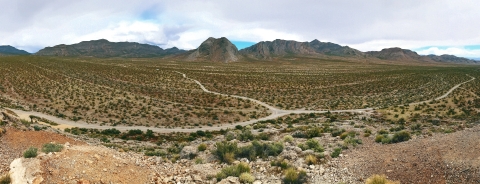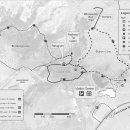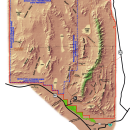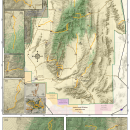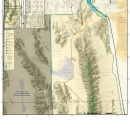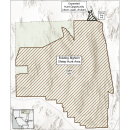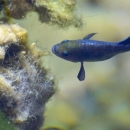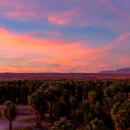Visit Us
National wildlife refuges offer us all a chance to unplug from the stresses of daily life and reconnect with our natural surroundings.
As the largest refuge in the lower 48 states, Desert NWR is an excellent place to visit, whether for a day trip or a longer stay. The refuge offers a wide variety of recreation opportunities, from birdwatching and leisurely strolls, to hiking and backpacking, to long drives on solitary four-wheel-drive (4WD) roads.
Visitor Center
Let our staff and volunteers at the Corn Creek Visitor Center help you plan your visit! This is a great starting point for visitors to become more familiar with the refuge and the wildlife that live here. Visitors can watch a 17-minute refuge orientation video, browse wildlife and human history exhibits, and obtain maps and brochures. The Corn Creek trail system leaves from behind the visitor center, and its 1.5 miles of trail winds through different habitats and past cultural remnants, an excellent way to start your refuge experience! Along the trail, take a peek at the endangered Pahrump poolfish in our refugium. Or, make your way to the railroad tie cabin, which was built with railroad ties from the abandoned Las Vegas & Tonopah Railroad. Old scars from the railroad spikes still mark the walls of this 1920s historic home.
Alamo Road
This rugged road traverses over 70 miles (113 km) to connect Desert NWR to Pahranagat NWR and Alamo. While the Dry Lake portion of the road is often impassable and closed due to hazardous conditions, there are many stops along the way that make it an excellent trip.
Hidden Forest
Approximately 16 miles (26 km) north of Corn Creek is Deadman Canyon, the trailhead for Hidden Forest. Starting among the creosote and Joshua trees, this six mile (9 km) hike travels through three life zones to a historic log cabin nestled among the ponderosa pine. For more information about this area, see this story.
Hayford Peak
A strenuous, yet rewarding 2.5 mile (4 km) hike from Hidden Forest Cabin, Hayford Peak is the highest point in the refuge at 9,924 feet (3,025 m). Dotted with twisted bristlecone pines, the oldest living organisms in the world, the scenic views from the top are breathtaking.
Mormon Well Road
Traveling through Desert Pass, this road covers 47 miles (76 km) to connect to US-93 near State Highway-168. The full route may be closed due to hazardous conditions – make sure to check with the refuge before you head out.
Fossil Ridge
Approximately 4.5 miles (7 km) from Corn Creek, is Fossil Ridge, a colorful outcropping of Devonian rocks. Numerous fossils can be seen on the sharp angled slopes, evidence of the inland sea that once covered the desert.
Desert Pass Campground
Located 28 miles (45 km) from Corn Creek is the Desert Pass Campground and Picnic Area. Surrounded by ponderosa pines, this fee-free area has picnic tables, primitive facilities, and six established campsites, making it a great place to escape the summer heat.
Gass Peak Road
Branching off of Mormon Well Road, Gass Peak Road takes you on an out and back through the Las Vegas Range. Four-wheel drive (4WD) is needed beyond Quail Springs Road, approximately 9 miles (14 km) after the Mormon Well Road turnoff.
Gass Peak
Named for Octavius Decatur Gass, an early settler of the Las Vegas Valley, Gass Peak is the highest point of the Las Vegas Range. Standing at 6,943 feet (2,116 m), the peak offers spectacular views of both the bustling city to the south and the vast wilderness to the north.
Activities
Things to Do
If you have 15-minutes...
- Stop by the visitor center for some information followed by a quick walk on one of the hard surfaced trails.
If you have one hour...
- Go birding! Corn Creek is one of the best spots in Southern Nevada to see migratory birds.
If you have half a day or more...
- Go for a drive on one of our many backcountry roads (4WD recommended and high-clearance required).
Visit the Refuge Virtually!
Don't live nearby, but still want to see what the refuge is all about? You can tour the refuge virtually, thanks to Vegas PBS and PBS Reno. Additional videos about the refuge can be found in the library.
Trails
Desert NWR is an excellent place to visit whether you are looking to take a leisurely walk, engage in some birding, or explore vast wilderness qualities on one of the rugged backcountry roads. If you’re looking for a longer visit, camping and hiking opportunities abound. At Corn Creek, there are several small, easy trails with a combined length of approximately 1.5 miles. These trails are:
For a full list of trails, including backcountry hiking opportunities, please stop by the Corn Creek Visitor Center, explore the interactive map, or see the maps shared in the next section.
Related Documents
All provided maps are for general location information only and do not imply access. For access information please check on the refuge's web page or contact the refuge directly. Many refuges have specific visitor services and other recreation opportunity maps. All lands and boundaries depicted in the above web map are not survey quality and should not be used for survey or legal purposes. For more information go to the USFWS Geospatial Services website.
Additionally, you can get downloadable maps directly from the U.S. Geological Survey.
An audio described version of the brochure is available, courtesy of UniDescription.
Other Facilities in the Complex
Desert National Wildlife Refuge (NWR) is managed as part of the Desert National Wildlife Refuge Complex. A National Wildlife Refuge Complex is an administrative grouping of two or more refuges, wildlife management areas or other refuge conservation areas that are primarily managed from a central office location. Refuges are grouped into a complex structure structure
Something temporarily or permanently constructed, built, or placed; and constructed of natural or manufactured parts including, but not limited to, a building, shed, cabin, porch, bridge, walkway, stair steps, sign, landing, platform, dock, rack, fence, telecommunication device, antennae, fish cleaning table, satellite dish/mount, or well head.
Learn more about structure because they occur in a similar ecological region, such as a watershed or specific habitat type, and have a related purpose and management needs. Typically, a project leader or complex manager oversees the general management of all refuges within the complex and refuge managers are responsible for operations at specific refuges. Supporting staff, composed of administrative, law enforcement, refuge manager, biological, fire, visitor services, and maintenance professionals, are centrally located and support all refuges within the complex.
Other refuges in the Desert National Wildlife Refuge Complex include: Ash Meadows NWR, Moapa Valley NWR, and Pahranagat NWR. The Refuge Complex headquarters is located at 4701 North Torrey Pines Drive, Las Vegas, Nevada 89130.
Rules and Policies
Know Before You Go
Visitors may enter the refuge between 4:00 a.m. and sunset. An automatic access gate was installed on Corn Creek Road in January 2023, and is now fully operational. The gate opens at approximately 4:00 a.m. and closes at sunset. Visitors can exit the refuge after sunset by slowly pulling up to the gate to activate the sensor and open the gate. The refuge remains open for backcountry camping; however visitors must enter the refuge between 4:00 a.m. and sunset. If those who are camping on the refuge leave and cannot return prior to sunset, they will be able to reenter the refuge at 4:00 the next morning. Emergency services are able to enter the refuge 24 hours a day.
If you are heading beyond Corn Creek, you need a high-clearance vehicle, and four-wheel drive (4WD) is suggested. Make sure your vehicle is ready for the trip - check your tires, fuel, fluids, and battery. The most common problem people experience is flat tires – a spare is a must!
Cell phone reception in the refuge is extremely limited. Don’t assume it will work! Make a safety plan before you go and always let someone know where you will be and when you plan to return.
Road conditions constantly change. Check current conditions ahead of time for updates, closures, or hazardous conditions.
Flash floods can happen quickly and during any time of year, particularly during the summer monsoons. A rainstorm miles away can cause a flash flood through a storm-free area. Keep to higher ground and avoid hiking and camping in washes and canyons. Flash floods are misleading in their depth and speed - never attempt to drive through or otherwise enter flood waters!
Weather here can be extreme. Temperatures may reach upward of 120°F (50°C) in the summer and can drop 50°F (10°C) in just 24 hours. Dress in layers and protect yourself from the sun.
Carry and drink at least one gallon (4 liters) of water per person per day. Water in springs and water developments (guzzlers) is for wildlife and emergency use only, with the exception of Wiregrass Spring near Hidden Forest Cabin. All water used must be purified prior to consumption.
Know your limits and be safe.
Refuge phone number: 702-879-6110
Non-emergency dispatch: 702-293-8998
Emergency dispatch: 702-293-8932
We want you and everyone to have a great time on your visit - please follow all Rules and Regulations.
We have several rules and regulations in place to help with the protection of our wildlife and their habitats, as well as for the enjoyment of all visitors to the refuge.
Please familiarize yourself with these before you come. We hope you enjoy your time at Desert NWR!
Locations
















To the Corn Creek Visitor Center
Traveling North on US-95 from Las Vegas:
Take US-95 North. 6 miles (9.5 km) past the Snow Mountain exit, at mile marker 101, turn right on Corn Creek Road. Continue down the paved road 4 miles to the Visitor Center.
Traveling South on US-95:
Take US-95 South. 4.5 miles (7 km) past Lee Canyon Road/NV-156, at mile marker 101, turn left on Corn Creek Road. Continue down the paved road 4 miles to the Visitor Center.
Other ways to enter the refuge
From Pahranagat National Wildlife Refuge:
On US-93 in Lincoln County, turn into the refuge office road at mile marker 32. Continue on Alamo Road, bearing right at the refuge office. Continue 2.25 miles (3.5 km) to border of Desert NWR.
From US-93:
Desert NWR can also be entered on the east side at Mormon Well Road. The turn-off is located 2 miles (3 km) south of the exit for NV-168 on US-93, at mile marker 80. If heading northbound, the turn-off is located approximately 32 miles (51.5 km) from the I-15/US-93 intersection.
Please note that these alternate entrances do not always connect to the Visitor Center.
Please check current road conditions before planning your trip.







